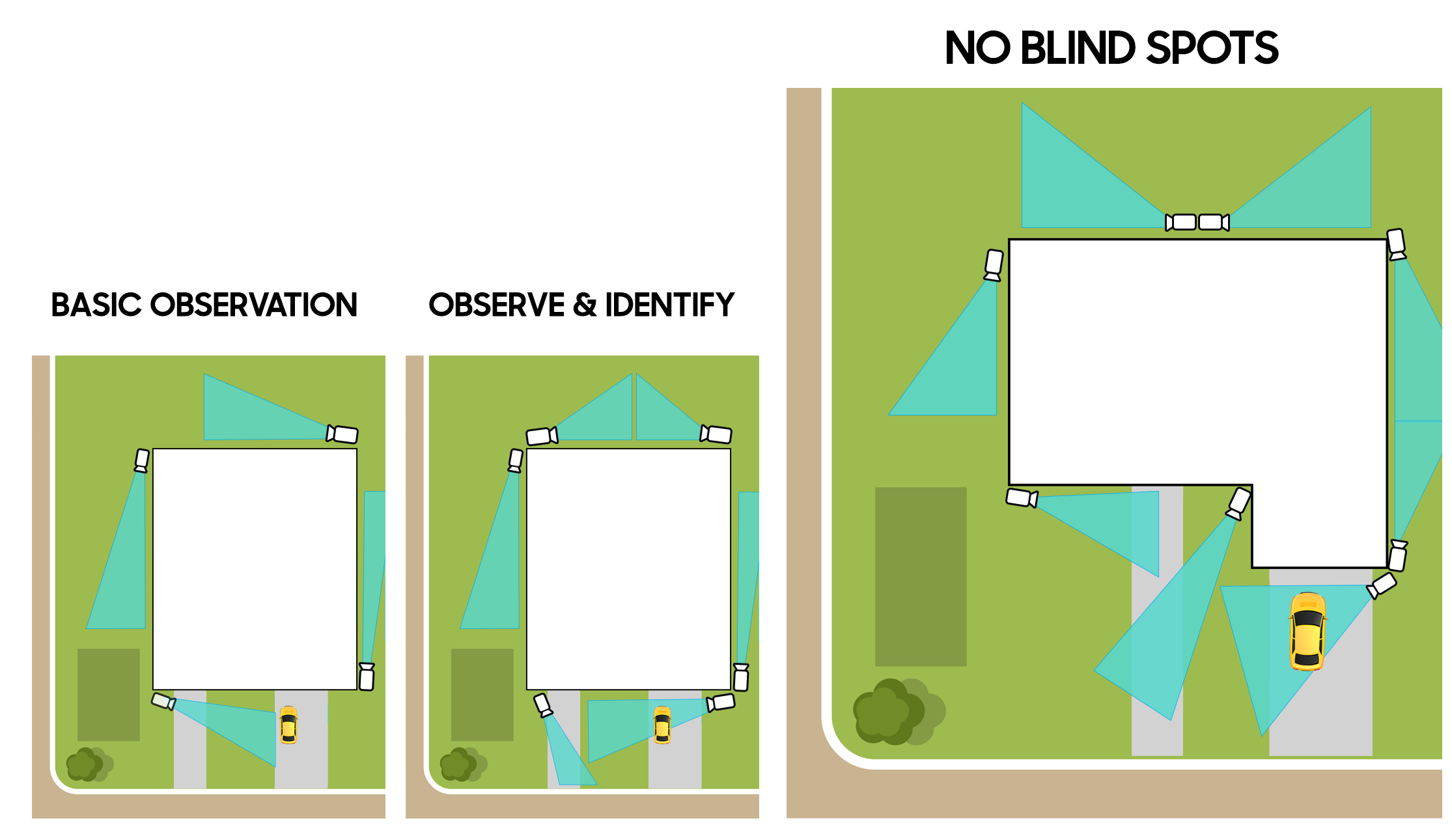How Should Security Cameras Be Positioned?
The easiest way to determine where to place security cameras for your home or business is to use common sense: figure out what you want to watch, and map out the ideal vantage points for the cameras.Of course, nothing’s quite that simple. There are a number of factors to take into consideration, including the type of equipment you’ll be using and the layout of your property.
Here’s a quick guide to optimal security camera positioning.
Residential or Commercial?
Security needs for homes and businesses are quite different. A monitoring system for a house is primarily designed to deal with two potential issues: burglaries and fires, affecting a relatively small area. Commercial properties, however, often require cameras to monitor employees, the security of sensitive data, and everything from shoplifting to the theft of valuable equipment. They may have to watch over a great deal of space which can span multiple buildings or even acres of land.Additionally, the aesthetics of security cameras and placement are usually more important for homes than commercial buildings.
Commercial monitoring equipment and systems, for those reasons, are more robust and not as “pretty” as consumer security equipment for the home market. Both are best installed by experienced professionals, but it is particularly important for businesses to use experts for design and installation.
Let’s look more closely, then, at security camera systems for homes.
Today’s Security Equipment Makes It Easy
In the early days of visual security monitoring, the one word that didn’t apply was “unobtrusive.” The first wired CCTV (closed-circuit television) wired security systems were used in the mid-1900s, primarily for government surveillance and monitoring purposes.The 1970s saw the popular introduction of video security systems. But they had large, often-motorized cameras that could only send grainy, still pictures to a TV monitor via dedicated cables, with the images refreshed every few seconds. A few years later, low-light cameras able to capture nighttime images entered the picture, and the feeds could be sent to brand-new VCR machines to record activity captured by cameras.
Cameras got smaller and smaller, and better able to capture detailed video, in the following years. And starting in the 1990s, CD and DVD recorders made video storage and access much easier.
However, the most important innovations arrived about 20 years ago: wireless IP cameras, and the networking that allowed high-quality video feeds to be transmitted digitally over virtually any distance. Later developments such as smart home security cameras, cloud or micro SD card storage, video content analytics (which can recognize motion, flames or smoke, and even faces) and laser focusing (allowing perfect image transmission in almost any environment) completed the development of what we now consider modern security systems. Most are also low-profile, meaning they won’t be easily noticed or mar the appearance of your property.
This equipment lets homeowners set up a relatively small number of sophisticated cameras to fully monitor their properties. Here’s how to do it.
Where to Put Your Security Cameras
 As we said at the start, common sense is a great guide. It’s not hard to put together a list of the areas where camera positioning is vital; think about the most vulnerable areas of your home, and locations where potential intruders aren’t visible to passers-by.
As we said at the start, common sense is a great guide. It’s not hard to put together a list of the areas where camera positioning is vital; think about the most vulnerable areas of your home, and locations where potential intruders aren’t visible to passers-by.- Front door: Approximately one-third of all burglars come in right through the front door, so it’s a crucial spot to watch. A camera here also allows you to interface with a smart doorbell system. Mount the camera well above the door if possible, or in a secure container, to prevent tampering by would-be intruders.
- Back or side doors: Nearly one-quarter of break-ins occur through these secondary entrances, so they should be monitored with high-angle or tamper-proof cameras as well.
- Lower-level windows: Another 25% of intrusions happen when burglars use easily-accessible windows that can’t be seen from the street.
- Garage and basement entrances, and upper-story windows: These entry points are used in only about 20% of break-ins, but additional monitoring cameras could be well worth the extra expense.

Types of Security Equipment to Use
The real key to designing an effective surveillance system is using the right types of cameras. There are two major categories.- Fixed lens cameras: These models display a single, fixed field of view (which means the area that’s visible in the picture). Most show a wide-angle view, and they are unable to zoom in or out on people or objects. Fixed lens models are primarily described by their focal length (4mm, for example), which determines what the camera can see at various distances. A higher focal length gives you better detail, but a much smaller field of view. These are best used for relatively-close views of smaller areas. Two good examples are Cmple’s 4-megapixel, low-profile fixed lens security camera and the Cmple 5-megapixel vandal-proof dome fixed lens security camera.
- Varifocal cameras: These cameras allow you to manually adjust the field of view as well as the focal length. They’re great for capturing wide-angle views if you can’t mount a camera close to the spot being watched, or to see details at a distance of more than 50 feet. They’re also more expensive than fixed lens cameras; some models can be controlled remotely via touchscreen or joystick, but most require manual adjustments to change the field of view or focal angle. You can take a look at Cmple’s 700 TVL varifocal dome security camera or the Cmple 1000 TVL varifocal security camera (TVL is a measure of picture quality) to see some of what’s available.
Any modern security system will need a DVR (often called NVR, or network video recorder) to record its feeds. They generally come in four-channel models for four camera feeds or 16-channel models which can handle as many as 16 different cameras. Cmple offers high-quality 4-channel security camera DVRs and 16-channel security camera DVRs at great prices.
Be sure the hard drive is large enough to archive the amount of video you want to save, and that the bitrate is high enough to handle the numbers and types of cameras you’re using. For example, each 4K camera requires a data transfer capacity of about 20 mbps, so a 40 mbps NVR wouldn’t be able to accommodate three 4K cameras. By contrast, a standard hi-def camera only requires 5 mbps, so a 40 mbps machine could handle 7-8 high-def cameras.
What NOT To Do
Here are some common mistakes people make when installing home security cameras.- They don’t secure and tamper-proof their cameras: Burglars will try to disable cameras before breaking in – it’s part of their “job training.” Cameras should be permanently mounted at least 9-10 feet above ground level, or installed in tamper-proof housings.
- They think their cameras can do everything: A wide-angle camera view may show lots of space, but that doesn’t mean it can also pick up the license plate of a burglar’s car. Cameras and systems should be designed to perform specific functions well, not many functions poorly.
- They put their cameras too high: A camera mounted on the roof may show a view of an entire property, but it probably won’t capture any details necessary to identify or apprehend an intruder.
- They don’t account for poor lighting: Nighttime, bright sun, stormy weather and other conditions can render a camera’s picture virtually useless. Providing the right amount of lighting, proper positioning of cameras and the use of low-light or infrared models are crucial to make a security system actually secure.
- They don’t call a professional when needed: Anyone can buy cameras and recording equipment, and many DIYers can install equipment. That often leads, however, to a poorly-performing security camera system. A certified home security installer can help with planning and design, provide equipment (often at a discount) and do the actual installation properly, at a cost far below what one undetected break-in might cost.
0
Featured products





